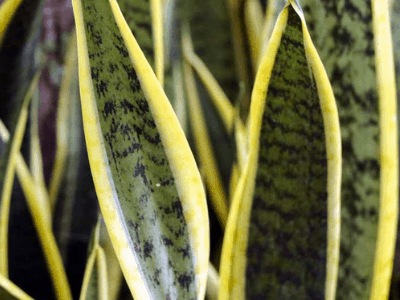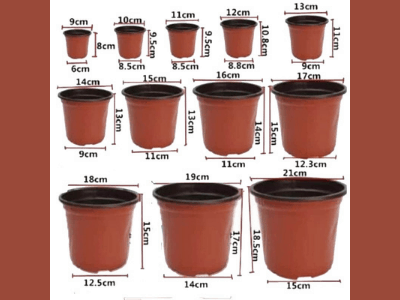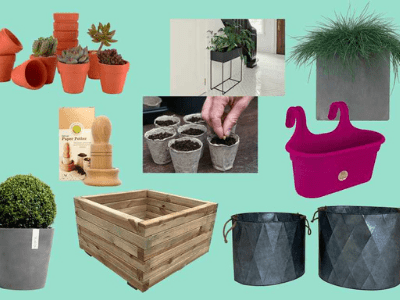Have you ever wondered why you never see fake snake plants?
It’s because artificial versions aren’t required…
The real thing is nearly unkillable and can grow in almost any environment…
Hear it from Finn!
I have had my snake plant for years now…
… and they’ve been the greatest companion a gardener ever asked for.
Before purchasing my snake plant, I had considered a lot of things…
… especially the pot for snake plants as they are susceptible to root rot.
From the size, material, and space of the pot…
… everything must be considered so my snake plant will grow at its best.
Keep that in mind…
So that you will also do the same when you purchase your own snake plant…
We provide links to vendors to assist you in finding appropriate products…
We may receive a commission if you purchase through one of our links…
Even as I was putting this together, I realized that our readers don’t need a Sansevieria growing guide…
All we have to do is consider what we don’t want to happen to a snake plant…
It thrives on neglect, like many houseplants, and suffers from too much love…
They Thrive On Neglect

Yes, you read that correctly. Snake plants don’t require a delicate touch to prune their foliage…
… and they don’t require much water.
They can withstand both deep shade and direct sunlight…
… as well as a few nights of freezing temperatures.
It also doesn’t require frequent repotting…
My aunt had a colony of snake plants in every room of her house…
… and she would never repot them until the rhizomes of their root-bound rhizomes cracked the clay pots.
It’s worth noting…
That the plant can easily be broken up and divided into multiples…
… each ready for a new home as a potted plant.
Because they evolved in the Congo’s jungles, this species can thrive in harsh conditions…
Jungles, despite being cradles of life and biodiversity, have poor soil quality…
That’s because those minerals and nutrients are trapped within the massive amount of vegetation…
To mimic the soil conditions of its native habitat, the snake plant prefers a cramped, low-quality home…
They Don’t Need Much Water
It’s because snake plants are one of the few species…
… that have evolved the crassulacean acid metabolism metabolic process.
Plants use their stomata to exchange gases and release water vapour in the process…
Many plants’ stomata can open or close in response to their surroundings…
… but Sansevieria only opens its stomata at night to conserve water.
For plants, however, gas exchange is often referred to as a “necessary evil”…
Plants use very little water in their metabolic processes…
… and they expel up to 95 percent of it through transpiration.
But what about snake plants?
Because their stomata are only open at night…
… they can hold water for much longer than your other houseplants.
If we give them too much water, they become waterlogged and start to rot…
Best Soil For Snake Plants

Snake Plants prefer to be kept dry, so the soil they’re planted in needs to be able to drain freely…
You don’t want it to retain too much moisture because root rot will occur…
Because the succulent and cactus mix is chunky and well aerated, I add it in…
As I’m planting, I also toss in a few handfuls of organic compost…
… (I use much less of both this and the worm compost when repotting houseplants…
… than I do when repotting container plants in my garden) and a 1/2′′ layer of worm compost on top.
The Pot For Snake Plant
What Size Pot for Snake Plant Should I Use?
In their pots, they prefer to grow slightly compact…
When I repot a Snake Plant, I increase the pot size by one…
If yours is in a 6′′ grow pot, for example, an 8′′ pot would be the best size to use…
Sansevierias don’t require a deep pot because they like to spread out as they grow…
A deep pot has more soil mass at the bottom, which may become too wet, resulting in root rot…
The Sanseviera “Laurentii” has been removed from the pot…
Preparation
Because the snake plant’s tall foliage can cause it to be top-heavy…
… it’s usually grown in pots that are wider than they are deep.
Choose a pot that is 1 to 2 inches larger in diameter than the old one when replacing it…
After watering, the pot must have at least one bottom drainage hole…
… to allow excess water to drain properly.
Fill the pot about one-third full with potting soil…
… formulated for tropical houseplants or a soil-based potting media.
Why Choose the Perfect Pot for Snake Plant?
Different plants require different types of care and soil, whether you want to grow Snake Plants…
… flowering plants, succulents, cacti, grasses, or trees.
As part of this care, you should select appropriate plant pots…

You can use terracotta pots and saucers or glazed pots…
… with hand-painted designs if you have a flowering plant.
We’ve compiled a list of the best Snake plant pots in this article…
We make our choice based on verified customer reviews of pots for Snake plants…
You can quickly make a buying decision after reading all of the comparisons…
… pros, cons, specifications, ratings, our favorites, and reviews of these pots for Snake plants.
So, what should you think about before purchasing the best pot for Snake Plants?
Factors to Consider When Buying Pot for Snake Plant
Consider how the style of the pot fits into the overall design of your home…
If your home is decorated in a modern style…
… a tall and slender pot would compliment and blend in nicely.
Casual and folk art pots should be used to compliment the country-style home…
Regardless of your home’s style, make wise decisions…
You must ensure that the design of the pot does not sparkle more than the plant…
Consider yourself as someone who is involved in plant care…
This means you’re discussing pot upkeep…
Terracotta pots have a tendency to absorb moisture quickly and dry out quickly…
A crackled and plain glaze is used to seal ceramic pots…
To prevent splintering and fading, you must seal wooden pots, which are usually unsealed…
You should consider the Snake Plant’s location…
Any pots you choose must be durable enough to withstand any weather conditions…
Drainage holes should be included in your pots…
Furthermore…
In wet and soft conditions, it’s susceptible to causing a snake plant root rot.
When the leaves are overwatered, they become droopy…
When the top 2 or 3 inches of soil are completely dry, you can water the Snake Plant…
Water them until the drainage hole is full of water…
Plan the location because Snake Plant only requires a small pot to be planted on your coffee table…
Place your Snake Plant in a tall area with plenty of room for it to grow…
Select a pot that will accommodate the plant’s growth…
For outdoor use, use a larger pot and larger Snake Plants…
To ensure that your snake plant grows neatly and without becoming sick…
… choose a pot that is the right size.
However, deciding on the container size, especially for new gardeners…
… can be a little perplexing. Here are some pointers to assist you with this.
Pot Size

To ensure you’ve sized your pot correctly, you first need to know how to measure it; planters come in different shapes, and, therefore, are measured in different ways. Round planters are most commonly sold by diameter, which refers to the distance measured across the top of the pot. Though pots may have the same diameter, this does not necessarily mean that they are the same size. Pots which are measured in trade gallons, for example, will refer to the volume of soil which can be held.
Tonya Barnett of FRESHCUTKY Cut Flower & Vegetable Garden
Although many plants prefer some space to spread out…
… too much or too little space can cause issues.
When a pot is too big, the soil dries slowly and retains moisture for a long time…
This can cause a plant to sit in water for an extended period of time…
It will make your snake plant more susceptible to root rot in the long run…
A pot that is too small, on the other hand, can cause the soil to dry out quickly…
The plant will need to be watered more frequently…
Furthermore, your plant may become root-bound, resulting in stunted growth…
When a snake plant grows too large for its container, it will tip over…
Growth Rate
You can use a pot that is the same size as the plant you just bought from the nursery for the new smaller plants…
When it comes to repotting, a plant has outgrown its current container…
As a result, select a pot with a diameter that is a few inches larger…
For plants that grow quickly, choose the 2-4 inch larger size…
A pot that is 1-2 inches larger is recommended for slow growers…
Snake plants, in general, are considered slow-growing plants…
Snake plants that are grown outside grow a little faster than those that are grown indoors…
Dwarf Sansevieria varieties, such as Sansevieria Trifasciata Hahnii…
… grow slowly and rarely reach more than 6 inches in width.
Pot Space
As previously stated, too much space can be detrimental to the plant…
As a result, don’t go overboard and drastically increase the size of the pot…
The plant will take a long time to spread out…
Meanwhile, it raises the risk of overwatering the plant…
Choose a pot that is 1-2 inches larger than the current size for the snake plants…
Pot Material

Not only do different pot materials have different looks and appearances…
… but they also have different functions.
Let’s take a look at some of the most common pot materials…
Pots made of terracotta or clay are fairly common and widely available in most areas…
It’s simple to find pots that match their shape and size…
Because these pots are porous, they can quickly drain water and keep the soil aerated…
Terracotta is an excellent choice for snake plants because of this quality…
They can come in a variety of patterns and look great because of their neutral color…
However…
There are some drawbacks to using clay pots as well…
They are heavier and more likely to break if dropped…
Extremely cold winter temperatures can cause them to crack…
Plastic pots are inexpensive, versatile, colorful, and lightweight…
They’re widely available, and they’re simple to clean and reuse…
Plastic pots usually come in a variety of shapes, sizes, and patterns…
They’re great for hanging baskets and other situations where pot weight is an issue…
Plastic does not allow any water to pass through because it is completely impermeable…
Water can’t evaporate from the sides like it can in terracotta pots, which is bad for snake plants…
Moreover…
Plastic pots must have drainage holes…
Otherwise, the roots of the snake plant will quickly rot…
Plastic pots tend to fade and become brittle in the sun…
Ceramic or glazed pots are commonly used indoors because they are so beautiful…
These pots are sturdy and come in a variety of shapes and sizes…
… making them ideal for smaller plants.
They’re heavy enough to keep top-heavy plants from overturning…
When it comes to drawbacks, ceramic is less porous than terracotta…
As a result…
You must keep an eye on the soil’s moisture level…
Large ceramic pots can be quite heavy and awkward to transport…
They’re also more expensive than other types of materials…
Concrete pots have a distinct appearance that may complement your decor…
Because concrete is a good insulator, it aids in maintaining a comfortable soil temperature…
They’re ideal for both small and large indoor and outdoor plants…
Concrete pots that are left outside are resistant to weather changes…
They will not crack even in the coldest winters or the hottest summers…
Concrete pots, as you might expect, are quite heavy…
It makes it difficult to use them for larger plants indoors…
The porosity of concrete varies depending on the type…
Planters and pots are frequently made of wood…
Wooden planters and pots are lightweight, watertight, and simple to make from scrap wood…
They have a natural, rustic appearance. Snake plants thrive in wooden containers…
Just make sure they’re made of rot-resistant woods like redwood, cedar, mulberry, yew, and other similar species…
Because containers can shrink or expand slightly, look for high-quality containers…
To prevent rot, splintering, and fading, they are usually painted with a non-toxic clear varnish or toner…
To sum it up…
See, having a Snake plant is a good choice for you to have! It’s cool, it’s famous, it’s easy to have and care for!
What else do you need? In this pandemic time like this, it is a good choice for you to have a new activity…
…and having a snake plant is a good choice for you to have!
Conclusion
Last thing for sure. This plant needs to be taken care of carefully. Remember, plants need the “love” too.
Alright, that’s all for today! Do you have any questions about all of this?
Or do you want to add some method to choose a pot for the snake plant itself?
Let me know your recommendation in the comment below, or contact us.
I hope you can now take care of your snake carefully and grow it big! Thanks for reading this article!
Check out more of our articles on this website, like this one here!
If your plant has this lovely blossom, enjoy the show!
Frequently Asked Questions Around How Big of Pot for Snake Plants
Do Snake Plants Like Big or Small Pots?
While snake plants are adaptable and will do well in a variety of containers…
…they prefer larger pots for optimal growth.
A pot that is at least 2 feet wide by 2 feet deep is ideal.
You can also try growing them in an upright position if you have limited space.
What is the Best Pot for Snake Plants?
If you’re looking for a pot that is suitable for a snake plant…
…then an earthenware or glazed ceramic pot might be the best option.
These pots are lightweight and easy to move around…
…which is ideal if you plan on keeping your snake plant indoors.
They also have wide openings that allow good airflow and drainage…
…so your plant won’t get bogged down in water or soil.
Additionally, these pots resist cracking or breaking when Weight is placed on them from above or below.
If clay pots are more appropriate for your needs, they can last several years…
…without needing watering unless there is heavy rainfall outside.
Clay pots do require some maintenance though; namely, periodic sweeping of…
…debris and adding a layer of organic matter (such as compost) every two months to keep the soil moist and fertilized.
Finally, if you’d like something with a bit more personality than…
…plain old potstery–perhaps one sporting beautiful artwork –then consider using an Old World vase style pot instead!
Can I Put My Snake Plant in a Large Pot?
Most snake plants can be put in a large pot, but it is important to check…
…the size of the pot and make sure that there isn’t too much water runoff.
Snake plants are heavy feeders and will not do well if their roots constantly get wet.
If you’re unsure about whether or not your snake plant will survive…
…in a larger container, place it in a small testing pot for several days before moving it into its new home.
How Do I Know if My Snake Plant Needs a Bigger Pot?
If your snake plant is growing rapidly and reaching the top of its pot, it may be time for a new one.
Snake plants like plenty of room to grow and are prone to stretching…
…their roots out of the pot if they’re not given enough space.
You can check the size of your plant by measuring from the bottom of its…
…root ball (where soil meets water) straight up toward the topmost leaves.
If your plant falls within either range on our growth chart…
…you should probably replace its pot with a larger one.
Should I Repot My Snake Plant?
Repotting a snake plant is not necessary if the root system has been properly established.
Overpotting can cause roots to rot or be inhibited, which will result in…
…unhealthy growth and poor health.
If you do decide to repot your snake plant, make sure to use fresh soil…
…and water that is specifically designed for plants.
You should also wait until after the new pot has started…
…to become dry before adding any additional water.
Do Snake Plants Like Ceramic Pots?
There is no definitive answer to this question, as each snake plant may prefer different types of pots.
Some people recommend using ceramic pots because they are inert…
…and do not contain metalzzi which can harm the plant.
However, other experts caution against using pottery alternatives due to…
…the fact that some snakes plants soil easily and Ceramic pots can become stained or even ruined.
So, it is up to you whether or not you want to try out a new pot for your snake plant!
Do Snake Plants Need Drainage Holes?
Snake plants do not need any drainage holes, as they are able to extract…
…moisture and salts from the soil through their foliage.
This is a unique feature that allows snake plants to survive…
…in areas where other plants would not be able to.
Can Snake Plants Stay Small?
Yes, snake plants can stay small if you water them correctly.
However, they may suffer in dry climates or if the soil is not well-drained.
If this happens, it is important to give your snake plant more water…
…than usual and to add quality plant food such as compost or fertilizers that are high in organic matter.
Additionally, make sure that the sunlight exposure your snake plant…
…receives is appropriate for its size and type of root system.
Should I Water My Snake Plant After Repotting?
Snake plants should not be watered after repotting…
…as doing so may cause the new soil to become too dry and damaging.
Instead, wait until the soil has dried out slightly before watering again.


